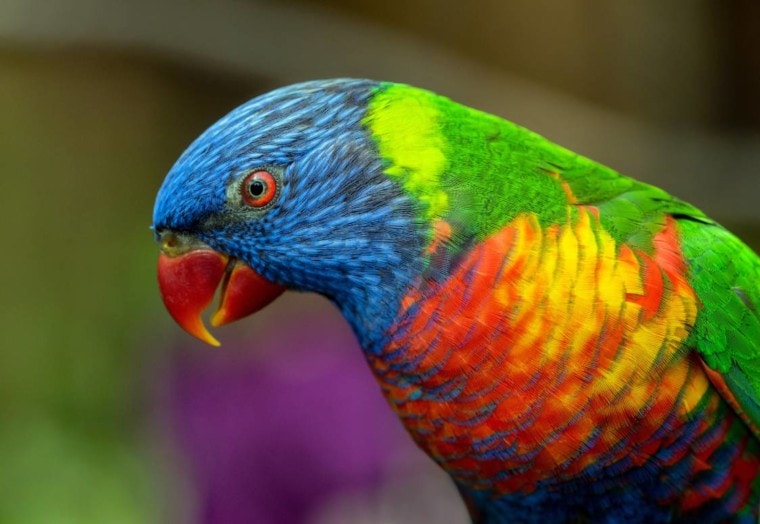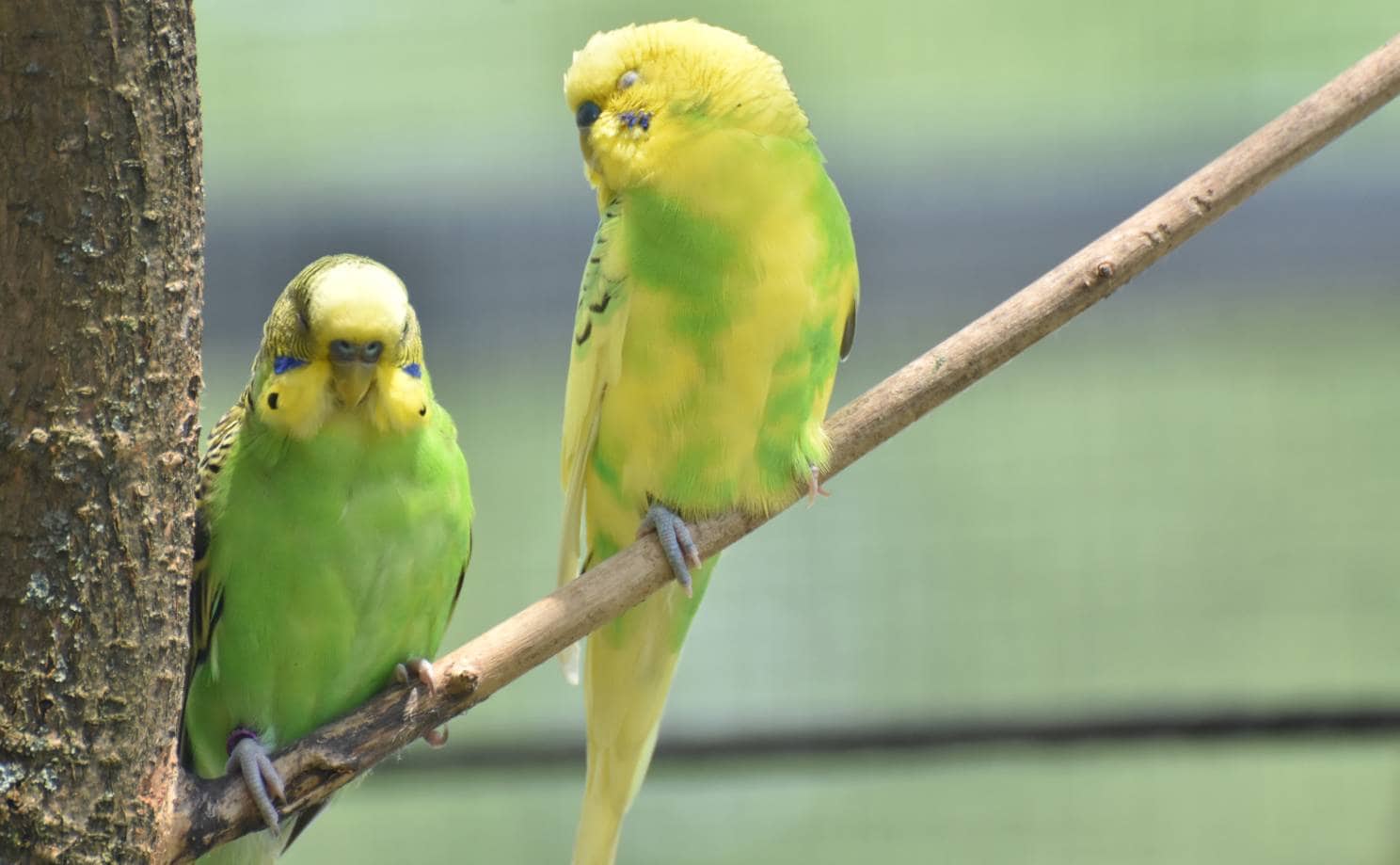
The Green-Naped, or Coconut Lorikeet is a subspecies of the Rainbow Lorikeet. Stunning creatures with a multi-colored appearance, these birds are outgoing, affectionate, and eager to play and move. Loud in nature, they can mimic human speech (and be trained to talk). If you’re a bird lover, you may find that this lorikeet is perfect for you.
 Species Overview
Species Overview
| Common Names: | Green-Naped Lorikeet, Coconut Lorikeet |
| Scientific Name: | Trichoglossus haematodus haematodus |
| Adult Size: | 10 – 12 in |
| Life Expectancy: | 15 – 30 years |
Origin and History
The Green-Naped Lorikeet is one of the most common subspecies of rainbow lorikeets. A member of the parrot family, you can recognize them by their vibrant, colorful plumage and vocalizations. Commonly found in Australia, New Zealand, Indonesia, New Caledonia, Papua New Guinea, and the Solomon Islands, these birds live in a variety of habitats such as rainforests, woodlands, swamps, mangroves, and coconut plantations (where they pollinate coconuts). The “haematodus” in their species name comes from the Ancient Greek haimatōdēs, meaning “blood-red”, an apt description of the red coloring on their chests. The Green-Naped Lorikeet was the first of the lorikeets to be bred in captivity.

Temperament
Green-Naped Lorikeets are very social birds (and if bred in captivity, particularly friendly). After you’ve gained their trust, you’ll find them to be highly affectionate (they love having their heads scratched!). An intelligent bird, the lorikeet is also curious and loves to play – especially in water. Bath time will be a big hit with these feathered friends.
While the Green-Naped Lorikeet is hardly ever aggressive towards people, they can be aggressive towards other animals due to their territorial nature. If you decide you want this lorikeet as a pet, they really should be the only animal in your home. They are highly active and energetic, requiring plenty of flying time. If these birds are left alone for too long, it can lead to behavioral issues, so keep that in mind if you work often or travel a lot.
Speech & Vocalizations
The Green-Naped Lorikeet makes a variety of sounds, from loud, shrill calls to high-pitched squawks to chirps to a long, drawn-out scream. Because they are noisy birds, they may not be ideal for people with children still of napping age or people with close neighbors such as those in apartments. If they’re awake, they will be making noise. While lorikeets are more mimickers than talkers, you can train them to talk by speaking to them in a tone that resembles their own high-pitched calls.
Green-Naped (Coconut) Lorikeet Colors and Markings
As a subspecies of Rainbow Lorikeets, the Green-Naped Lorikeet lives up to that moniker. They are beautiful birds that indeed feature a rainbow of color. The head is a dark blue that fades to a green or brown as it goes down the neck. Their collar is a mix of yellow and green, while their throat and breast are a vivid red. Their belly, tail, and back are bright green. Their wings are also green, with the underwing feathers having red-orange and yellow tips and the primaries having black tips. Their hooked beaks are a red-orange as well. Male lorikeets irises are red, while the females are more of a red-orange.
 Caring for the Green-Naped (Coconut) Lorikeet
Caring for the Green-Naped (Coconut) Lorikeet
You should know several things when it comes to caring for a Green-Naped Lorikeet, such as how to house them, items they’ll need, how to clean up after them and how to keep them well-groomed. These birds require many things (not least your time and attention), so they are less suited to first-time pet owners. So, how should you prepare to bring one of these lovely birds home?
The first item you’ll need will be a large cage. You’ll also want a lock for the cage door; these birds are smart enough to escape. On the inside, include plenty of perches for your bird to hang out on, along with food and water dishes that can clip onto the cage. Because lorikeets spray their feces, it will land outside the cage as well as inside, so you’ll want to put the cage in a spot that’s easy to clean up (think tile or other hard floors, not on the carpet). If you want to make cleaning easier, line the cage with newspapers.
The cage should be cleaned every day to remove any waste. Plus, you should sanitize food and water dishes and clean perches regularly. Before you give your bird fresh food, remove any leftovers to prevent your pet from eating anything spoiled.
Green-Naped Lorikeets love to play, so you’ll want to provide a variety of toys to keep them entertained. Examples of toys your lorikeet will love include toys that make noise, hanging toys such as rings that they can climb and chew on, foraging and puzzle toys, and ladders and swings. If you rotate your bird’s toy collection, it will help keep them mentally stimulated. Also, keep in mind that these energetic birds will need to be outside their cage quite often so they can fly around.
Keeping your lorikeet clean shouldn’t be much of a problem since they love baths. Include a shallow bath inside their cage so they can bathe as often as they want. Alternatively, you can bathe them with mist spray.

Common Health Problems
As a rainbow lorikeet, the Green-Naped Lorikeet is prone to a handful of health issues, a few of which are diet-related. The lorikeet’s diet is highly specialized, so if they aren’t fed the right foods, they can develop nutritional deficiencies such as lack of Vitamin A. Likewise, an improper diet can lead to obesity.
These birds are also susceptible to lorikeet paralysis syndrome. While it happens more often in the wild, it may occur in captive birds too. Symptoms include paralysis of the wings, body, heads, or legs and the inability to blink or swallow.
Lorikeets may also develop infections such as crop infections, yeast infections, and bacterial infections. And while it is less common in this type of bird, if your they become exceptionally bored, stressed, or anxious, they may start plucking their feathers, a form of self-injury.
A few common signs of sickness to watch out for include lethargy, weight loss, feather irregularities such as color changes or signs of plucking, or refusal of food. If you see any of these signs, get your bird to the vet right away. Also, remember to take your bird for regular check-ups to prevent issues before they start.
Diet and Nutrition
The Green-Naped Lorikeet has a diet different from other parrot species in that it is a primarily liquid diet. Wild Green-Naped Lorikeets will consume mainly nectar and pollen, along with some fruits and the rare seed. Pet lorikeets will have a similar diet.
Obviously, you can’t provide nectar, but you can give them a nectar replication that comes in the form of a powder that is mixed with water. This creates a liquid with the consistency of nectar and provides the nutrients your bird needs. Don’t limit your bird’s diet to just this though! Your pet will also enjoy and benefit from fresh fruit such as apples, mangoes, pears, peaches, grapes, and cherries. Citrus fruits such as oranges or lemons may upset their stomach, so those are to be avoided.
Also crucial for your pet is fresh water; the more, the better!

Exercise
Green-Naped Lorikeets are energetic, high-activity birds who need regular exercise for optimal health and to prevent boredom. They should spend several hours each day outside their cage so they can fly around freely and exercise their wings. You can also engage them in exercise via toys that encourage movement, like swings or ladders. Other ways to play include games of fetch or hiding food in their cages for them to hunt out. Make sure they exercise their beaks by stocking up on plenty of toys that can be chewed on that are made of bird-friendly woods.
Where to Adopt or Buy a Green-Naped Coconut Lorikeet
You can find your new pet Green-Naped Coconut Lorikeet in a few different places. If you’re looking to buy, you should check reputable bird breeders or specialty avian stores. You might find one in a pet store, but you’re more likely to find one through a breeder or specialty store. You should be prepared to shell out a few bucks for your new bird as they can cost anywhere between $400 and $1500 (plus more for all the necessary supplies such as a cage, toys, and food).
You can also try adopting a Green-Naped Lorikeet by checking out a reputable pet adoption site. It might be more difficult to find one this way, but you may find them to be a little cheaper if you succeed.
 Conclusion
Conclusion
The Green-Naped (coconut) lorikeet can be a fun addition to your home due to their friendly and energetic nature. However, they do require hours of attention each day, so you may find them to be a less than ideal pet if you aren’t often home. Some folks also find their loud, talkative natures overwhelming, so consider whether you’re truly up for a pet on the noisy side. The most important thing when it comes to these beautiful birds is making sure you have the time, money, and willingness to care for them properly before you buy. They’ll be in your life for a while, so make sure it will be an enjoyable experience for all before making your final decision!
Featured Image Credit: Xizmena, Shutterstock
 Species Overview
Species Overview





